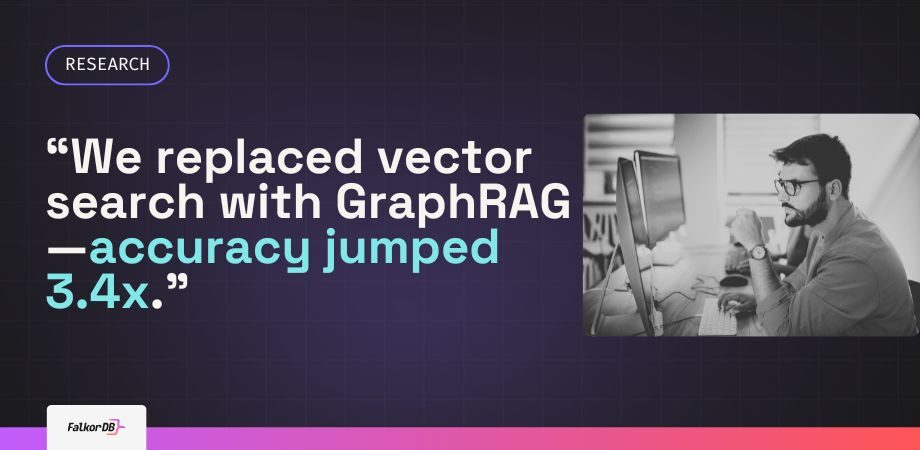- Vector RAG scored 0% on schema-bound queries like KPIs and forecasts—GraphRAG is the only architecture that recovered performance.
- FalkorDB’s 2025 SDK pushed GraphRAG to 90%+ accuracy—up from 56.2% in Diffbot’s original benchmark—without adding rerankers or filters.
- If your GenAI system isn’t schema-aware, it’s just a demo. Production-grade retrieval requires graphs—period.
Why Enterprise Queries Need More Than Vectors
In late 2023, Diffbot released the KG-LM Accuracy Benchmark, a public study evaluating how knowledge graphs impact the performance of large language models (LLMs) in enterprise scenarios. The benchmark tests how well LLMs answer 43 business-relevant questions—with and without access to a structured knowledge graph.
The research compares traditional vector search pipelines to graph-based retrieval (GraphRAG), quantifying differences in accuracy across categories like operational analytics, KPI tracking, and strategic planning. For software architects evaluating RAG techniques in enterprise stacks, this benchmark surfaces a critical insight: vector embeddings are not enough when queries depend on structure.
If you’re still running vanilla RAG on high-entity queries, you’re flying blind. Here’s what the data proves—and why forward-leaning teams are already moving to graph-native stacks.

Defining GraphRAG
GraphRAG uses a knowledge graph as the retrieval substrate instead of unstructured document vectors. The graph explicitly encodes entity relationships, making it easier for an LLM to retrieve schema-aligned context. This contrasts with standard vector search, which uses embedding-based similarity to retrieve context without structural alignment.
Study Objective
The benchmark compares LLM performance across 43 enterprise-specific questions in four categories:
- Day-to-day analytics
- Operational analytics
- Metrics & KPIs
- Strategic planning
The benchmark measures accuracy with and without knowledge graph integration.
Results: GraphRAG Triples Accuracy in Enterprise Settings
Overall Accuracy
- LLM without KG grounding: 16.7%
- LLM with KG grounding (GraphRAG): 56.2%
- Accuracy gain: 3.4x increase
“This study shows that using a knowledge graph is not just beneficial—it’s functionally required for certain classes of enterprise questions.” — Mike Tung, CEO, Diffbot [1]
Performance Breakdown

These results confirm that vector-only systems cannot handle schema-intensive queries. Both Metrics & KPIs and Strategic Planning categories saw zero accuracy from traditional vector RAG.
Schema Dependence and Entity Density
- Accuracy degrades to 0% as the number of entities per query increases beyond five (without KG support).
- GraphRAG sustains stable performance even with 10+ entities per query.
This trend reinforces that surface-level similarity alone is not sufficient for high-entity-density queries.
“Graphs give structure to knowledge that language models alone can’t replicate.” — Kurt Bollacker, Data Scientist [2]

Practical Implications for Developers
When to Use GraphRAG
Use GraphRAG instead of traditional RAG when:
- Queries involve business logic or metric definitions
- Answers require multi-hop relationships between entities
- Schema conformity is critical (e.g., KPIs, forecasts, system state)
Tooling and Frameworks
- FalkorDB: A high-throughput graph database optimized for GraphRAG use cases. See FalkorDB Docs.
- LangChain: Supports graph-based retrievers and can integrate with FalkorDB for hybrid pipelines.
GraphRAG is a Structural Requirement
Since the benchmark was published in 2023, FalkorDB has released a production-grade GraphRAG SDK that further improves retrieval alignment and LLM accuracy. In internal tests conducted in Q1 2025, average response accuracy for enterprise-style questions increased from the 56.2% reported in the original benchmark.
The most significant improvements occurred in KPI tracking and planning queries, where structural fidelity is critical. Internal evaluations show measurable improvements beyond the original 56.2% benchmark accuracy, especially in schema-dense enterprise use cases.
GraphRAG outperforms vector-based retrieval when schema precision matters. The KG-LM Accuracy Benchmark shows a 3.4x accuracy gain overall, and an infinite gain in schema-heavy categories where vector search fails entirely. These results validate using a graph database like FalkorDB as the retrieval backend in production LLM pipelines.
Why did vector RAG fail on Diffbot’s benchmark?
What changed with FalkorDB’s GraphRAG SDK in 2025?
Can vector search ever match GraphRAG for structured data?
Build fast and accurate GenAI apps with GraphRAG SDK at scale
FalkorDB offers an accurate, multi-tenant RAG solution based on our low-latency, scalable graph database technology. It’s ideal for highly technical teams that handle complex, interconnected data in real-time, resulting in fewer hallucinations and more accurate responses from LLMs.
References and citations
- [1] Diffbot. “KG-LM Accuracy Benchmark.” November 2023. https://diffbot.com/benchmarks/kg-lm-accuracy
- [2] Bollacker, K. (2023). Presentation at Knowledge Graph Conf. https://www.knowledgegraph.tech/



